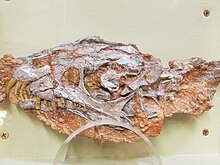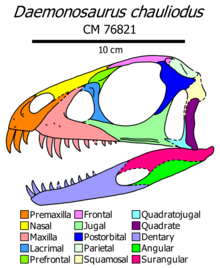Daemonosaurus
| Daemonosaurus Temporal range:
| |
|---|---|

| |
| Cast of the skull, displayed at the Ruth Hall Museum at Ghost Ranch | |
| Scientific classification | |
| Domain: | Eukaryota |
| Kingdom: | Animalia |
| Phylum: | Chordata |
| Clade: | Dinosauria |
| Clade: | Saurischia |
| Genus: | †Daemonosaurus Sues et al. 2011 |
| Species: | †D. chauliodus
|
| Binomial name | |
| †Daemonosaurus chauliodus Sues et al. 2011
| |
Daemonosaurus is an
Discovery

Daemonosaurus is known from a single fossil, the
Daemonosaurus was named by
Description
Daemonosaurus is notable for its short, deep skull, with large teeth, a rounded orbit (eye socket) and a relatively small antorbital fenestra.[1][2] Based on the proportions of related theropods, Daemonosaurus is estimated to have been around 1.5 m (5 feet) long according to Sues.[3] An estimate by Holtz (2012) suggests that Daemonosaurus was at most 2.2 m (7 ft) long with a weight around that of a beaver, 9.1–22.7 kilograms (20–50 pounds).[4] These estimates are almost entirely conjectural, as no postcranial fossils are preserved beyond a few vertebrae. The proportionately large orbit, the short snout, and the apparent lack of fusion between the bones of the braincase suggest that the holotype specimen CM 76821 may be a juvenile. On the other hand, the closure (fusion) of the neurocentral sutures in the vertebrae suggest a mature individual.[1]
Cranium

The
Similar to many early dinosaurs, a small
The nasal is smooth and likely did not participate in the antorbital fossa. Each nasal has M-shaped sutures with the premaxilla and frontal, a more complex configuration than in other early dinosaurs. The lacrimal is thinnest at mid-height and sends a sharp projection along the lower edge of the orbit. It forms the rear edge of the antorbital fossa via a subtle ridge. The prefrontal is proportionally large, forming about half the upper edge of the orbit. The size of the prefrontal is unique to Daemonosaurus among dinosaurs and archosaurs in general. The frontals are wide and flat, separated from each other at the front by a wedge-shaped projection of the nasals. Their rear edge is excavated by the supratemporal fossa, which extends onto the broad and mostly flat parietal, as well as the fairly large postorbital. The postorbital likely contacted the frontal along a straight edge (like Tawa and Herrerasaurus), while also sending a rounded overhanging projection into the orbit (like most early saurischians).[1][2]
The jugal is moderately deep, with a thick front prong. Like neotheropods and a few sauropodomorphs, the rear edge of the jugal bore a deep notch for the front of the quadratojugal. The jugal’s lower edge has a sharp ridge that projects straight down, an unusual configuration not seen in other dinosaurs. The quadratojugal is lightly-built, with narrow front and upper prongs similar to Eoraptor. At its upper extent it contacts the squamosal, a poorly-preserved bone with an overall boxy shape. The quadrate is tall and narrow.[1][2]
Fragments of the
Lower jaw
The front of the mandible (lower jaw) has a slightly downturned tooth row, similar to many sauropodomorphs. The symphysis (chin) is dotted with small pits and converges towards a sharp margin. The dentary (tooth-bearing portion of the jaw) has an estimated 10 teeth, which are curved and serrated. The first tooth is large and slightly inset from the tip of the jaw, the second tooth is the largest in the lower jaw, and the rest decrease in size to the back of the jaw. The rear of the jaw is poorly-preserved but appears to be similar in structure to that of Herrerasaurus.[1][2]
Vertebrae
Fragments of five
Classification
Daemonosaurus is typically considered to be a basal
Examination of this genus by Sues et al. (2011) demonstrates that Daemonosaurus is separate and distinct from its other contemporaries.[1] Daemonosaurus differs from Herrerasaurus based on key features in the skull and because it has much larger teeth in the premaxilla. Daemonosaurus differs from Eodromaeus based on features of the jaw bone, skull, cheek bones, and because it has much larger teeth in the premaxilla. Daemonosaurus differs from Eoraptor lunensis based on the presence of much larger premaxillary and anterior maxillary teeth and a much more restricted antorbital fossa on the maxilla. Daemonosaurus differs from Tawa hallae and Coelophysis bauri in features of the skull bones. Daemonosaurus differs from Chindesaurus bryansmalli in features of the cervical vertebrae.
A paper published by Baron et al. (2017) resurrected the clade Ornithoscelida to unite ornithischians and theropods to the exception of sauropodomorphs.[6] Although not included in the original study, the authors added Daemonosaurus to their dataset after their hypothesis was criticized by a team of international researchers, Langer et al. (2017).[7] In Baron et al.'s response, Daemonosaurus was found to be the earliest ornithischian, retaining many theropod-like characteristics.[8]
Nesbitt and Sues (2020) rescored the genus and reran the analyses of both Langer et al. (2017) and Baron et al. (2017). Langer et al.'s analysis resulted in a large
Dinosauria
|
| |||||||||||||||||||||||||||
Paleoenvironment
The only specimen of Daemonosaurus was recovered at the Coelophysis (Whitaker) quarry at Ghost Ranch in Rio Arriba County, New Mexico. This site preserves pebbly, calcareous conglomerate rich in fossils of many different animals, with the theropod dinosaur Coelophysis being particularly abundant. It has been correlated the Siltstone Member of the Chinle Formation, which is tentatively dated to the Rhaetian (or possibly latest Norian) stage of the Late Triassic period.[1][2]
Ghost Ranch was located close to the equator 200 million years ago, and had a warm, monsoon-like climate with heavy seasonal precipitation. The
Taphonomy
The multitude of specimens deposited so closely together at Ghost Ranch was probably the result of a flash flood event. Such flooding was commonplace during this period of the Earth's history and, indeed, the nearby Petrified Forest of Arizona is the result of a preserved log jam of tree trunks that were caught in one such flood. In 1989, Colbert noted that the Daemonosaurus specimen and several Coelophysis specimens were washed into a small pond, where they drowned and were buried by a sheet flood event from a nearby river."[10]
References
- ^ PMID 21490016.
- ^ .
- ^ a b c Choi, C.Q. (12 April 2011). "T. Rex had a toothy ancestor that couldn't cut it". Live Science. Retrieved 12 April 2011.
- ^ Holtz, Thomas R. Jr. (2012) Dinosaurs: The Most Complete, Up-to-Date Encyclopedia for Dinosaur Lovers of All Ages, Winter 2011 Appendix.
- S2CID 232313141.
- S2CID 205254710.
- S2CID 205260354.
- S2CID 205260360.
- ISSN 0895-9811.
- ^ a b E. H. Colbert. 1989. The Triassic dinosaur Coelophysis. Museum of Northern Arizona Bulletin 57:1-174
